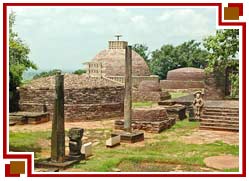
Sanchi, crowned with clusters of stupas and monasteries, is one of the most significant visitations of Buddhists from all corner of the globe. Tucked away at an elevation of 1423 ft, it is actually a small town in the state of Madhya Pradesh. The serene vistas of Sanchi, bedecked with architectural remnants belonging from 3rd century BC to 12th century BC, make the place a historical benchmark for exploring Indian Buddhism. In 1989, these ancient relics of the place were incorporated in the World Heritage enlistment.
The serenity of Sanchi, underlined by its well-preserved monuments in the form of stupas, chaityas, monasteries, temples and gateways, is in consonance with the teachings of Hinayana Buddhist Philosophy. This predominance of Buddhism, in the form of its artwork, makes the place an important religious site of the Buddhists. Apart from being a major pilgrimage destination, Sanchi also unearths the various facts associated with the genesis, efflorescence and culmination of Buddhist art and architecture, covering a span of 1500 years.
Though a place that conjoins the various dimensions of the Buddhist religion; ironically Sanchi was never visited by Buddha during his lifetime. It was in reality the place where King Ashoka gave expression to his newly acquired fervor and reverence for the religion. This religious zeal of Ashoka led to the outcropping of a large number of Buddhist monuments in the place, which still resound with spiritual messages. Though not hallowed by any significant phase of Buddha's life, the mystical contemplation of the place cannot be denied.
Its religious, architectural and archaeological connotations make Sanchi a popular tourist corner, for delving into the true realms of the Buddhist religion. The overpowering sense of calm felt in the place is increased manifold by its panoramic landscape. The well-entrenched lookout points, scattered amidst the hilltops, are ideal for soaking the bucolic tranquility of the place. The Buddhist ambience of the place, coupled with breathtaking beauty, elevates one to the higher planes of spiritual rejuvenation and exaltation. For people willing to experience succoring beauty while in a vacation; Sanchi remains unrivaled.







